Abstract
All Candida albicans isolates in Norwegian microbiological laboratories in 1991 judged clinically important (except vaginal isolates) were collected. The isolates were tested for susceptibility to fluconazole with an agar dilution test and a commercially available agar diffusion test. A total of 212 strains (95%) were susceptible to fluconazole, and MICs for most of the strains (92%) were < or = 1.56 micrograms/ml. The agar diffusion test using a 15-micrograms tablet and a 48-h incubation period separated resistant from susceptible strains with a wide margin. The only exception was a strain for which the MIC was 6.25 micrograms/ml. The difference in zone size between the resistant and the susceptible populations of strains was 11 mm. Accordingly, it appears that the agar diffusion test is an appropriate method for detecting fluconazole resistance. The 12 fluconazole-resistant isolates originated from eight AIDS patients with oral or esophageal Candida infections. Seven of the patients had been given fluconazole for 1 month or more, often as self medication. Four had infections that were clinically resistant to fluconazole; one additional patient responded only when the dose was increased. All isolates recovered from these patients were analyzed by multilocus enzyme electrophoresis. The 12 C. albicans isolates belonged to five electrophoretic types, but three of four patients attending one hospital had isolates belonging to one electrophoretic type. One possible explanation for this finding could be that a nosocomial spread of resistant strains has occurred.
Full text
PDF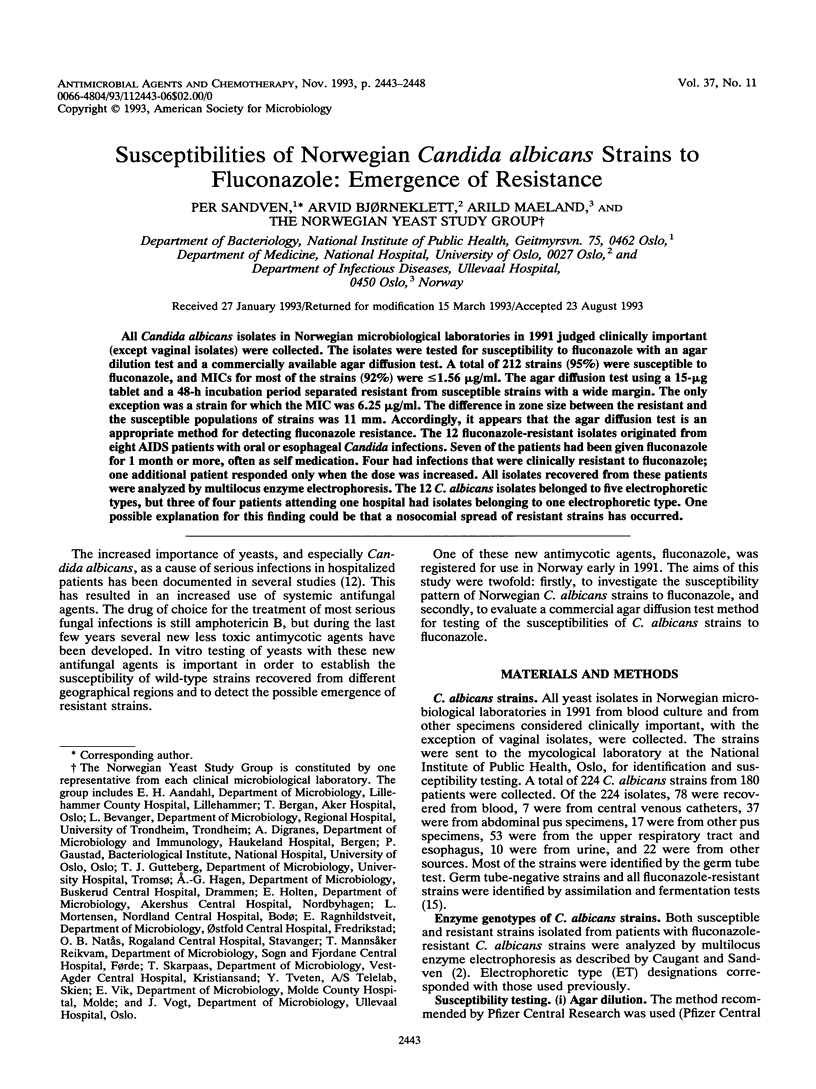
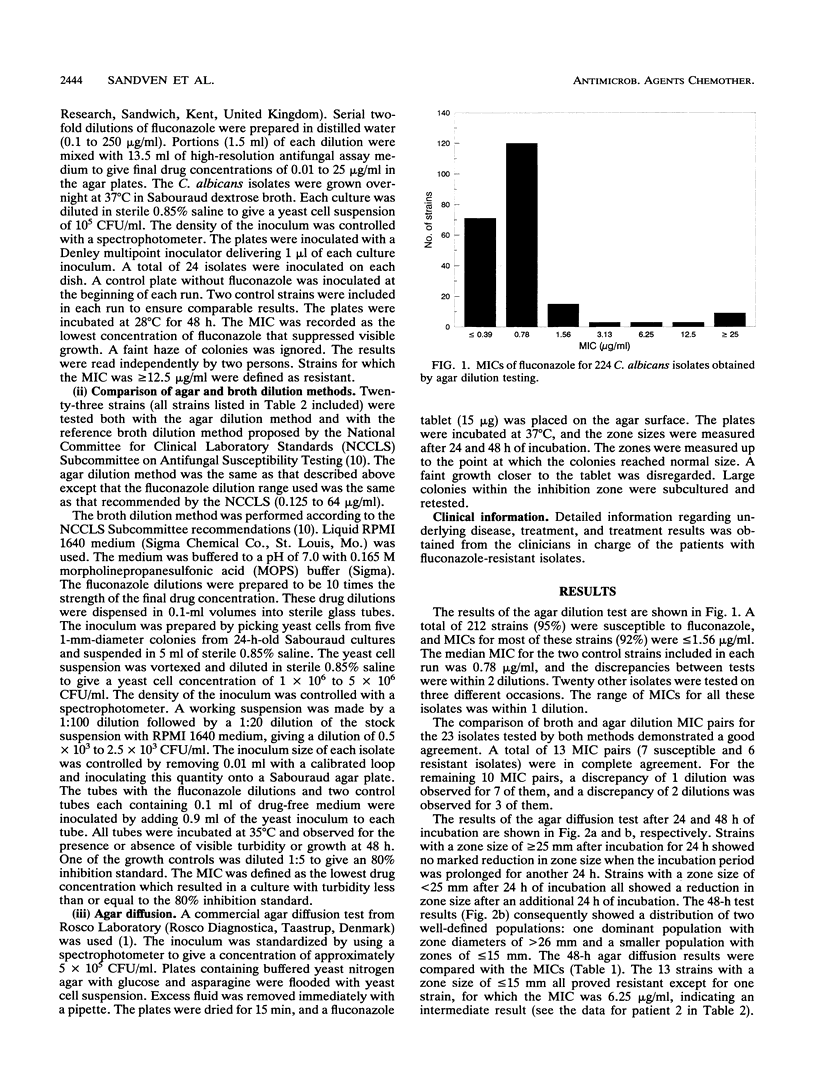
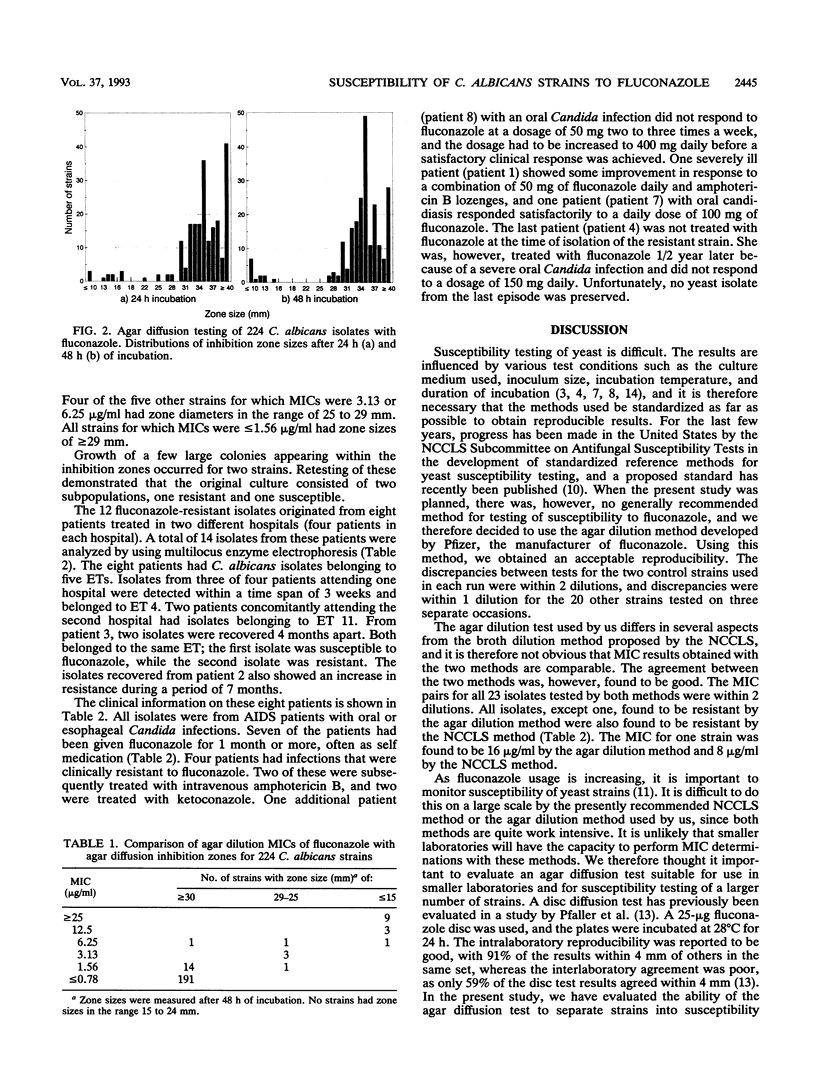
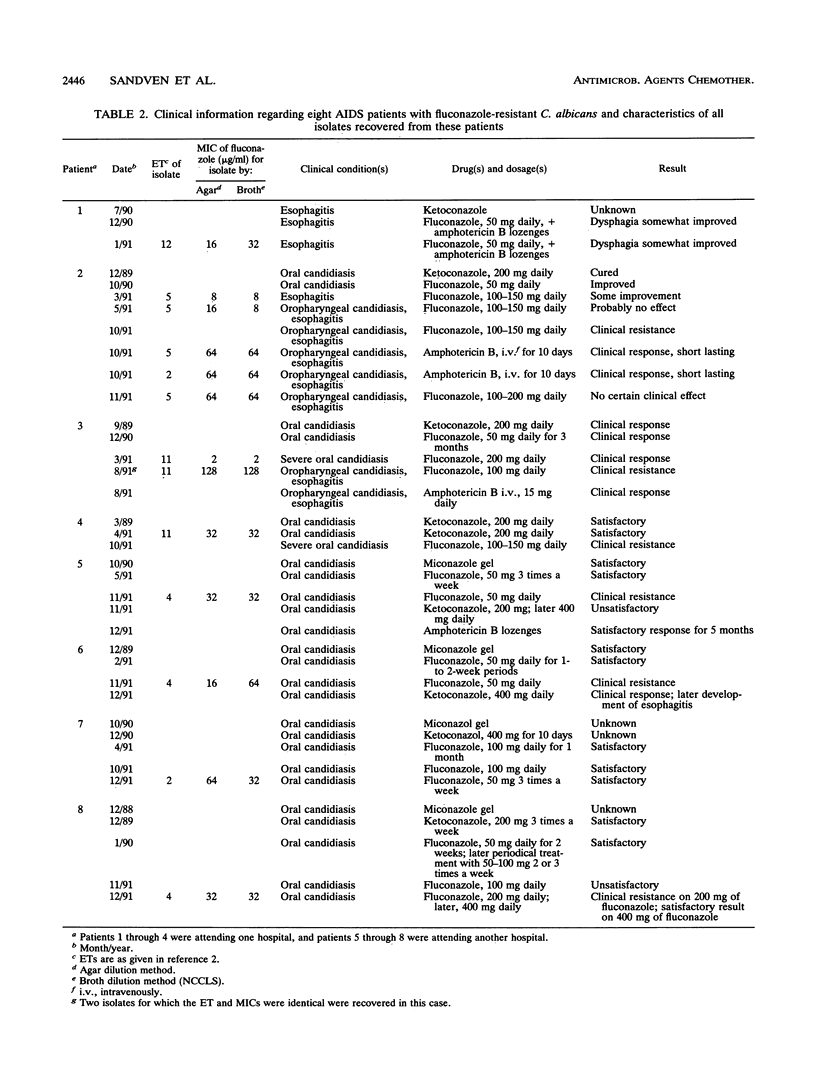
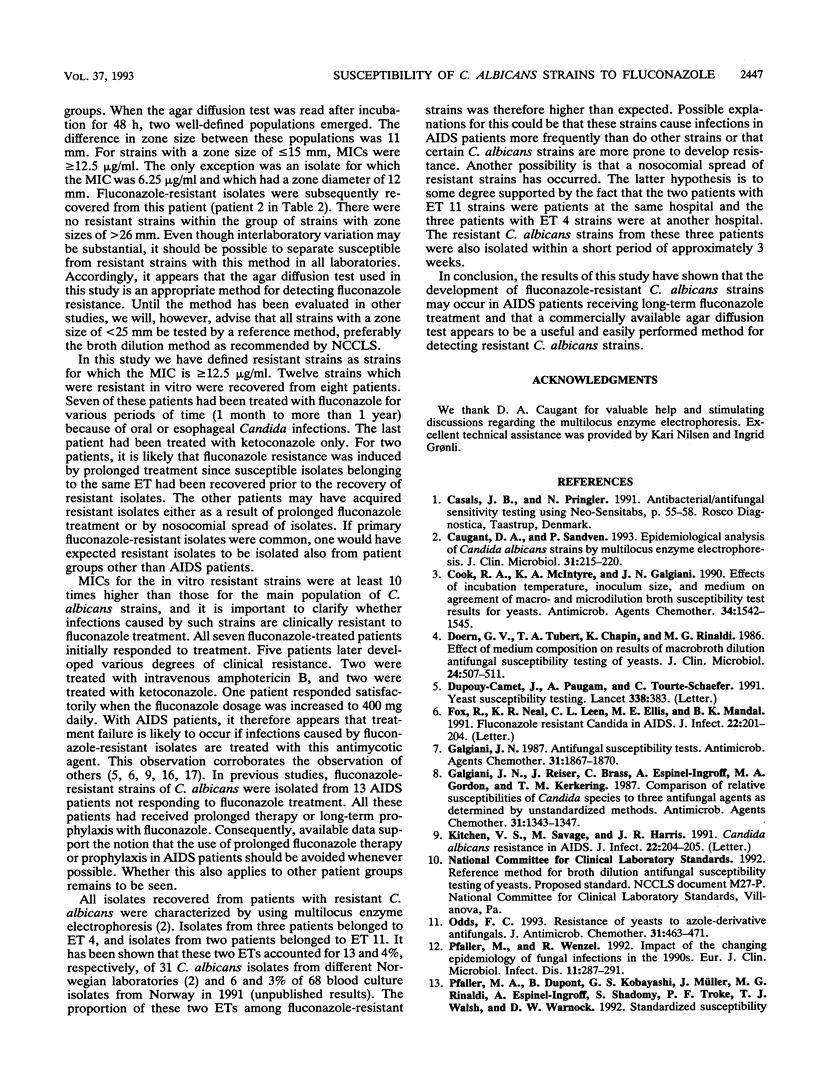
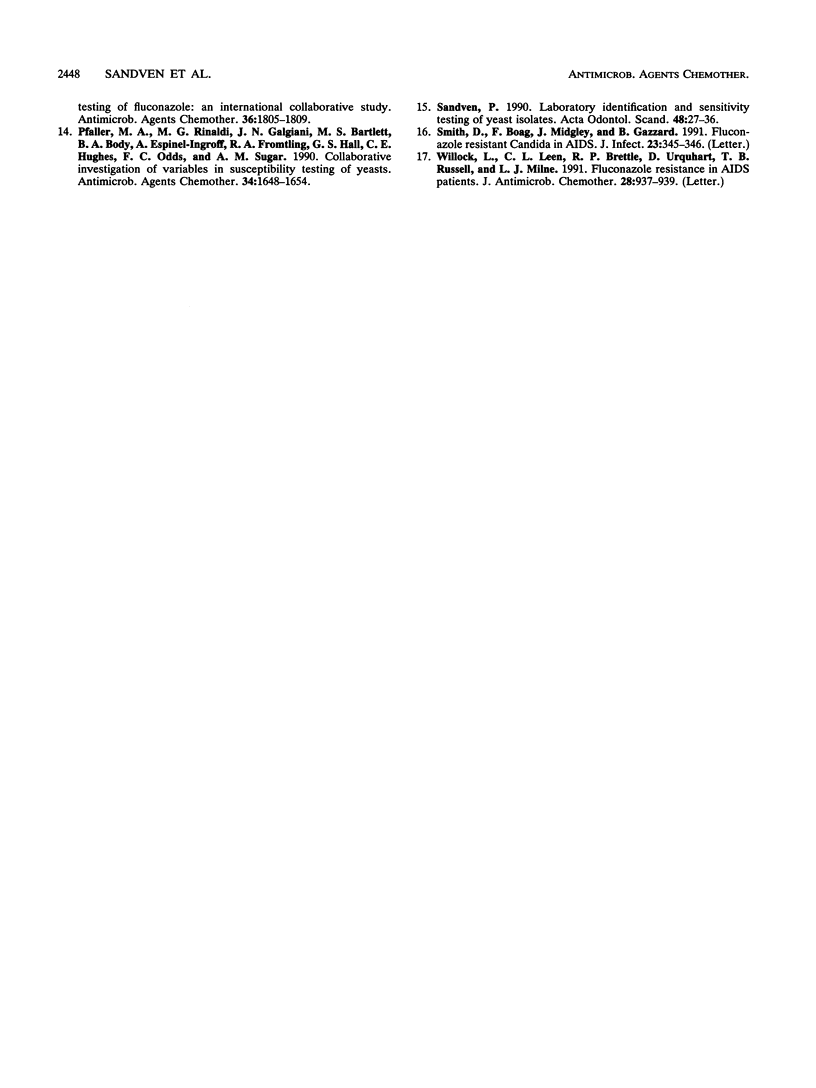
Selected References
These references are in PubMed. This may not be the complete list of references from this article.
- Caugant D. A., Sandven P. Epidemiological analysis of Candida albicans strains by multilocus enzyme electrophoresis. J Clin Microbiol. 1993 Feb;31(2):215–220. doi: 10.1128/jcm.31.2.215-220.1993. [DOI] [PMC free article] [PubMed] [Google Scholar]
- Cook R. A., McIntyre K. A., Galgiani J. N. Effects of incubation temperature, inoculum size, and medium on agreement of macro- and microdilution broth susceptibility test results for yeasts. Antimicrob Agents Chemother. 1990 Aug;34(8):1542–1545. doi: 10.1128/aac.34.8.1542. [DOI] [PMC free article] [PubMed] [Google Scholar]
- Doern G. V., Tubert T. A., Chapin K., Rinaldi M. G. Effect of medium composition on results of macrobroth dilution antifungal susceptibility testing of yeasts. J Clin Microbiol. 1986 Oct;24(4):507–511. doi: 10.1128/jcm.24.4.507-511.1986. [DOI] [PMC free article] [PubMed] [Google Scholar]
- Dupouy-Camet J., Paugam A., Tourte-Schaefer C. Yeasts susceptibility testing. Lancet. 1991 Aug 10;338(8763):383–383. doi: 10.1016/0140-6736(91)90514-p. [DOI] [PubMed] [Google Scholar]
- Fox R., Neal K. R., Leen C. L., Ellis M. E., Mandal B. K. Fluconazole resistant candida in AIDS. J Infect. 1991 Mar;22(2):201–204. doi: 10.1016/0163-4453(91)91767-r. [DOI] [PubMed] [Google Scholar]
- Galgiani J. N. Antifungal susceptibility tests. Antimicrob Agents Chemother. 1987 Dec;31(12):1867–1870. doi: 10.1128/aac.31.12.1867. [DOI] [PMC free article] [PubMed] [Google Scholar]
- Galgiani J. N., Reiser J., Brass C., Espinel-Ingroff A., Gordon M. A., Kerkering T. M. Comparison of relative susceptibilities of Candida species to three antifungal agents as determined by unstandardized methods. Antimicrob Agents Chemother. 1987 Sep;31(9):1343–1347. doi: 10.1128/aac.31.9.1343. [DOI] [PMC free article] [PubMed] [Google Scholar]
- Kitchen V. S., Savage M., Harris J. R. Candida albicans resistance in AIDS. J Infect. 1991 Mar;22(2):204–205. doi: 10.1016/0163-4453(91)91789-z. [DOI] [PubMed] [Google Scholar]
- Odds F. C. Resistance of yeasts to azole-derivative antifungals. J Antimicrob Chemother. 1993 Apr;31(4):463–471. doi: 10.1093/jac/31.4.463. [DOI] [PubMed] [Google Scholar]
- Pfaller M. A., Rinaldi M. G., Galgiani J. N., Bartlett M. S., Body B. A., Espinel-Ingroff A., Fromtling R. A., Hall G. S., Hughes C. E., Odds F. C. Collaborative investigation of variables in susceptibility testing of yeasts. Antimicrob Agents Chemother. 1990 Sep;34(9):1648–1654. doi: 10.1128/aac.34.9.1648. [DOI] [PMC free article] [PubMed] [Google Scholar]
- Pfaller M., Wenzel R. Impact of the changing epidemiology of fungal infections in the 1990s. Eur J Clin Microbiol Infect Dis. 1992 Apr;11(4):287–291. doi: 10.1007/BF01962067. [DOI] [PubMed] [Google Scholar]
- Sandven P. Laboratory identification and sensitivity testing of yeast isolates. Acta Odontol Scand. 1990 Feb;48(1):27–36. doi: 10.3109/00016359009012731. [DOI] [PubMed] [Google Scholar]
- Smith D., Boag F., Midgley J., Gazzard B. Fluconazole resistant candida in AIDS. J Infect. 1991 Nov;23(3):345–346. doi: 10.1016/0163-4453(91)93584-y. [DOI] [PubMed] [Google Scholar]
- Willocks L., Leen C. L., Brettle R. P., Urquhart D., Russell T. B., Milne L. J. Fluconazole resistance in AIDS patients. J Antimicrob Chemother. 1991 Dec;28(6):937–939. doi: 10.1093/jac/28.6.937. [DOI] [PubMed] [Google Scholar]


